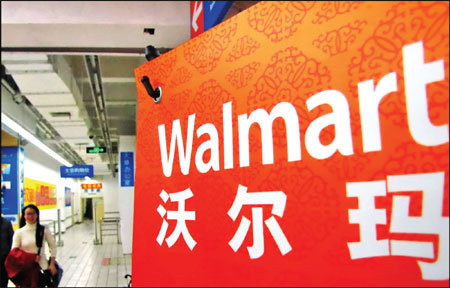Wal-Mart in acquisition mode
|
Customers browse through a Wall-Mart store in Shanghai. The chain is looking to expand even more in China. Jing Wei / for China Daily |
Wal-Mart Stores Inc, the world's largest retailer by sales, reportedly is looking at acquisitions in Chinese cities where it's not already the dominant player, according to the head of the company's Asia division.
Scott Price said at the Asia Pacific Economic Cooperation conference in Bali, Indonesia, that the retailer would consider deals with foreign companies, the Wall Street Journal reported Saturday.
"We want to grow in areas where we aren't present today," Price told the newspaper, while declining to disclose details about regions or potential companies.
Wal-Mart is seeking to have the lowest prices within a 2-kilometer (1.25-mile) radius of its stores to ensure it offers the lowest prices on 500 key items, Price said.
The company is investing 500 million yuan ($82 million) to upgrade its Chinese stores, according to Price, and Wal-Mart's China division has a stronger compliance system and a new management team this year. He said its online arm, Yihaodian, in which Wal-Mart bought a 51 percent stake last year, now has 24 million users, double from last year.
In a separate interview with the Economic Times of India, Price discussed the China market.
"I see a lot of angst, for whatever the reason, around China's reduction in its GDP forecast," he said. "I think most economies in the world would kill for China's reduced number. Let alone its absolute growth. We see China as a very important market and we're very optimistic about it."
Euromonitor International says China Resources Enterprise Ltd (CRE) and Wal-Mart shared second place last year in China's hypermarket industry with market shares of nearly 11 percent each. Sun Art Retail Group Ltd, backed by Groupe Auchan SA of France, was top with a 14 percent share.
Last week, CRE signed an agreement with Tesco PLC, Britain's biggest retailer, to create a retail joint venture in China. The joint venture, aiming to become the leading retailers in seven of the eight most populous and economically advanced provinces in China, would combine Tesco's 134 stores as well as its shopping mall businesses with CRE's 2,986 stores.
With sales of some 10 billion pounds ($16.2 billion), Tesco will have a 20 percent stake, and CRE the remaining 80 percent.
In July, Wal-Mart said it will open more Sam's Club stores - membership-only warehouse clubs targeting affluent Chinese families - in the next two or three years to cope with the slowdown of its hypermarket business.
Andrew Miles, senior vice-president and chief operating officer for Sam's Club in China, said then that Wal-Mart is expected to open seven Sam's Club stores.
Sam's Club, which opened its first store in China in Shenzhen in 1996, has 10 stores in the country. The company provides memberships for individual shoppers and business customers, but the majority of its clients are individual shoppers. Sam's Club customers pay 150 yuan ($24.23) per year for shopping at the stores. Having fewer items in the clubs than in supermarkets is one of the ways the company keeps prices low.
The rapid development of Sam's Club is in sharp contrast with Wal-Mart's decision to close some stores in recent months, resulting in questions and doubts over foreign retailers' plans in the Chinese market.
China Daily



















